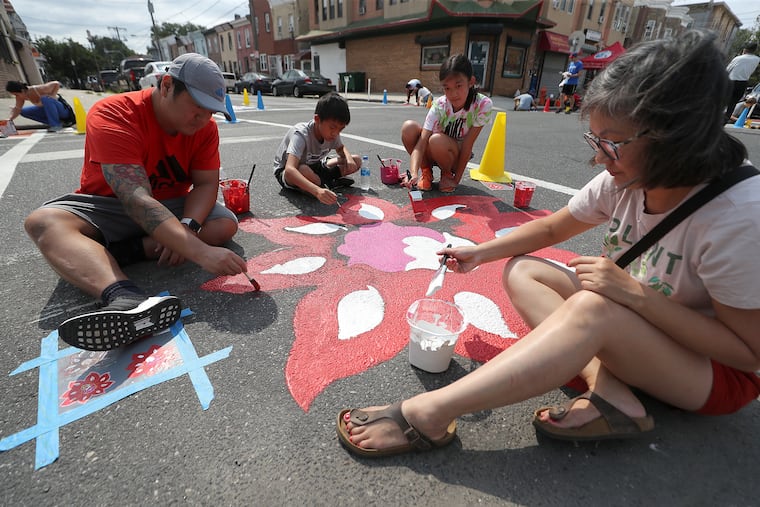In the heart of South Philly’s Southeast Asian community, painting a street mural to improve pedestrian safety and ‘create a sense of hope’
The project, run by the Southeast Asian Mutual Assistance Association Coalition (SEAMAAC), aims to serve business owners and residents who hail from countries such as Cambodia, Vietnam, and Honduras.

On a breezy summer morning, community members crouched over the four corners of the intersection at Seventh and Wolf to paint a street mural that organizers hope will improve pedestrian safety, help bring business to the stores on the corridor and, as Somaly Osteen puts it, “create a sense of hope.”
Osteen, a Cambodian immigrant who manages the South Philly commercial corridor along Seventh Street for the Southeast Asian Mutual Assistance Association Coalition (SEAMAAC), said that after a hard year for the largely immigrant neighborhood and its businesses, the mural is being created to send the message: “Even though there’s some challenges, there’s still some good things.”
The mural project was dreamed up by Osteen in 2019. The 32-year-old won a $5,000 “Emerging City Champions” Knight Foundation grant that year to install the mural after holding a series of meetings with residents and business owners to get their input. They decided on a mix of fabric patterns and flowers that evoke the diverse community in the area. Of the more than 60 businesses on the corridor from Mifflin to Porter Streets, half are Cambodian-owned, while others are owned by entrepreneurs who hail from countries such as Vietnam, the Dominican Republic, China, Honduras, and Myanmar, Osteen said.
One of those business owners was among the two dozen who came out to paint Sunday morning: Nor Farida, who just opened a grocery store down the street at Seventh and Durfor at the end of April. Her store — Nor Halal Meats and Groceries — sells food and snacks from her native Myanmar, as well as other Asian countries, including fruit jellies from Myanmar, Super Onion Crackers from Indonesia, and a boxed mix to make martabak, a Southeast Asian bread that can be either savory or sweet.
“I had wish to start business,” said Farida, who came as a refugee to Philadelphia in 2015. Osteen and SEAMAAC helped her get permits and forgivable loans to open the store, and so she was giving back to SEAMAAC, she said, as she painted a bright purple flower on the corner of the block. Later, she sliced a platter of fruit for the volunteers.
» READ MORE: He painted murals in Beijing. Now, he dreams of painting Chinatown.
The mural is part of a larger beautification and safety effort run by SEAMAAC for the neighborhood. The organization recently strung lights across the intersection at Seventh and Wolf and is working with Mural Arts and artist Shira Walinsky on a mural at Eighth and Wolf that SEAMAAC staffer Andrew Niemynski described as an “abstract community map.” Osteen says she hopes to get more funding so she can install more street murals at other intersections to help give residents and business owners a sense of ownership over the neighborhood, even as they struggle with violence and drug dealing in the area.
The mural is intended to make the intersection safer by attracting the attention of drivers, who will then slow down and stop, instead of rolling through stop signs. It is especially hoped that this will make the walk safer for families taking their children to the nearby Francis Scott Key School, Osteen said.
“That Philly slide!” said Henry Ross, a 34-year-old who’s lived in the neighborhood all his life. “They gotta eliminate that Philly slide.”
Murals aiming to slow traffic and increase pedestrian safety have been installed in cities such as St. Paul, Minn.; Baltimore; and Philadelphia — the South of South Street Neighbors Association worked with Mural Arts to install one in Graduate Hospital this year. Philadelphia had a higher rate of traffic-related deaths than New York City, Chicago, and San Francisco, according to 2018 data from the National Highway Traffic Safety Administration.
» READ MORE: In South Philly, a garden where immigrants grow foods that taste like home
Neighborhoods that are largely home to people of color and those living in poverty are more likely to experience these accidents, according to the City of Philadelphia’s Vision Zero Action Plan 2025, which aims to lower the number of traffic deaths to zero by 2030.
The mural was initially designed by Harrison Doyle and updated by Chenlin Cai, a Chinese immigrant who previously partnered with the Philadelphia Chinatown Development Corporation to paint a street mural on the Vine Street Plaza in Chinatown. The installation was delayed a year because of the pandemic.